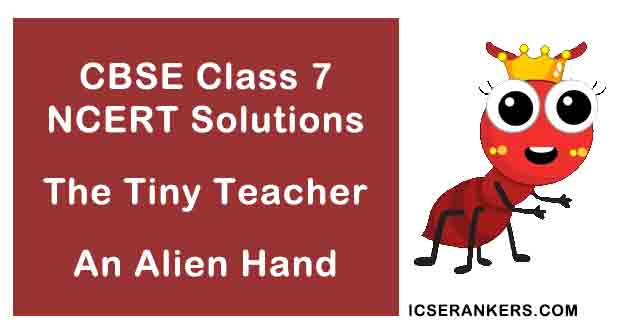NCERT Solutions for Chapter 1 The Tiny Teacher Class 7 English An Alien Hand
The author of 'The Tiny Teacher' is Gill Vaisey. This chapter tells us about an ant who can be a great teacher if we look closely at him. There are many things that ants can teach us about discipline and how to become disciplined. While they are so small, they carry out their duties with full dedication. Essentially, they do their work with a great deal of sincerity.

Chapter Name | The Tiny Teacher NCERT Solutions |
Class | CBSE Class 7 |
Textbook Name | An Alien Hand |
Related Readings |
|
Question 1: The story of an ant's life sounds almost untrue. The italicized phrase means
(i) highly exaggerated.
(ii) too remarkable to be true.
(iii) not based on facts.
Answer:
A statement that sounds untrue may or may not be true factually, so 'not based on facts' cannot be the answer. It is possible for even an unexaggerated thing to sound untrue. (ii) is the correct answer.
Question 2: Complete the following sentences.
(i) An ant is the smallest, _____
(ii) We know a number of facts about an ant's life because _____
Answer:
(i) commonest, but the wisest insect.
(ii) people have kept ants as pets, and have watched their daily behaviour closely.
Question 3: In what ways is an ant's life peaceful?
Answer:
The life of an ant is peaceful because each ant carries out its duties intelligently and bravely without fighting with other members.
Comprehension Check II
Question 1: How long does it take for a grub to become a complete ant?
Answer:
A grub becomes a cocoon after about two to three weeks. After three weeks, the cocoon breaks and the ant emerges.
Question 2: Why do the worker ants carry the grubs about?
Answer:
The worker ants feed and clean the grubs. Daily, they air, exercise, and expose them to the sun.
Question 3: What jobs are new ants trained for?
Answer:
New ants receive a week's training to learn their duties as workers, soldiers, builders, cleaners, etc.
Question 4: Name some other creatures that live in anthills.
Answer:
Other creatures that live in anthills include beetles, lesser breeds of ants, and greenflies.
Question 5: Mention three things we can learn from the 'tiny teacher'. Give reasons for choosing these items.
Answer:
'Tiny teacher' teaches us to work without fighting, which is the most important lesson. The ants do their work religiously and do not interfere with one another's work. Each ant plays its role efficiently, and they each have well-defined responsibilities. As well as searching for food, ants do their share of work intelligently and bravely. The ants are disciplined and clean, and they take care of their young. They also train and teach young ones in this manner. They teach us how to work together in harmony and do our own chores responsibly.
In addition, all humans must learn from their loyalty to the land where they live.
Exercises
Question 1:
(A) What problems are you likely to face if you keep ants as pets?
Answer:
We will likely face many problems if we keep ants as pets. Here are a few of them:
(i) They can cause many health problems when they fall into our food.
(ii) Our raw eatables, such as sugar, vegetables, fruits, sweets, etc., may be consumed and destroyed by them.
(iii) It is possible that they will bite us. The bite of an ant is particularly harmful to newborns.
(iv) The number of lizards at home may increase since they eat ants.
(B) When a group of bees finds nectar, it informs other bees of its location, quantity, etc. through dancing. Can you guess what ants communicate to their fellow ants by touching one another's feelers?
Answer:
An ant may communicate the location of food, risky in their way, or the need for soldier ants. During daily training sessions, they may discuss the arrival of other ants coming from the opposite direction or their development as young ants.
Question 2: Complete the following poem with words from the box below. The
recite the poem.
Soldiers live in barracks
And birds in _____,
Much like a snake that rests
In a _____. No horse is able
To sleep except in a _____.
And a dog lives well,
Mind you, only in a _____.
To say 'hi' to an ant, if you will,
You may have to climb an _____.
Answer:
The words given in options are hole, kennel, nests, anthill and stable.
All these words represent the place of living of some or the other animal, so the blanks need to be filled in accordingly.
The first blank needs a word which can describe where the birds live, which is nest, hence nests can be filled in the first blank.
A snake rests in a hole, hence the second blank should be filled by the word 'hole'. A horse lives in a stable, hence the third blank should be filled by 'stable'. A dog lives in a kennel, hence the fourth blank should be filled by 'kennel'. An ant lives in an anthill, so the last blank should be filled by 'anthill'.
